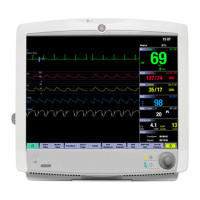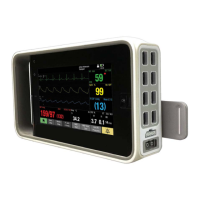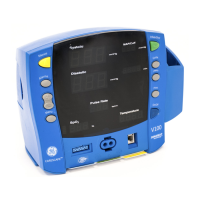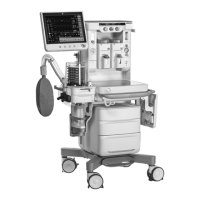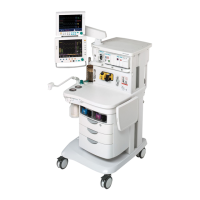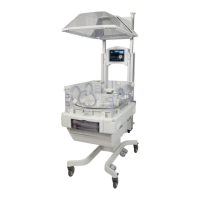Do you have a question about the GE CARESCAPE B850 and is the answer not in the manual?
Describes the purpose and scope of the manual for installation, maintenance, and repair.
Identifies the target audience as service representatives and technical personnel.
Explains typographical conventions for terms, menu items, and commands.
Defines naming conventions for the monitor and its various modules.
States that illustrations are examples and names are fictitious.
Instructs on how to request paper copies of manuals.
Lists other relevant GE Healthcare manuals and documents.
Lists trademarks owned by GE and third parties.
Identifies third-party trademarks used in the manual.
Outlines manufacturer responsibilities related to safety, reliability, and performance.
Notes that product availability may vary by country.
Provides general safety statements regarding device usage and accessory compatibility.
Explains the meaning of signal words like Danger, Warning, Caution, and Notice.
Explains various safety-related symbols used on the device and in the manual.
Provides an overview of the CARESCAPE Monitor B850 as a modular multi-parameter patient monitor.
Lists the main parts composing the patient monitoring system.
Describes the primary function and service interface of the CPU unit.
Details the monitor's configurability, software packages, and licensing model.
Lists and describes the available USB input devices like keyboard, mouse, and barcode reader.
Explains the function of F5 and F7 E-module frames as interfaces.
Introduces multiparameter hemodynamic modules like PDM and E-PSMP.
Describes compatibility with CARESCAPE Network MC and S/5 Network infrastructures.
Details connectivity to the CARESCAPE Network IX for accessing various services.
Explains the Unity Network ID device for acquiring and transmitting peripheral bedside data.
States that the monitor supports up to three independently configurable displays.
Describes the monitor's capability to print to recorders and laser printers.
Introduces Webmin as a browser-based interface for configuration and diagnostics.
Details the controls and indicators on the front view of the display.
Shows and labels the connectors and switches on the rear of the CPU unit and display.
Outlines requirements for servicing, warranty, and disposal.
Explains the Unique Device Identifier (UDI) and device labeling.
Describes security features like access control, authentication, authorization, and audit.
Details network security requirements for MC, S/5, and IX networks.
Emphasizes GE's software verification process for updates.
Provides web addresses for detailed product security information.
Details how to access Webmin via the monitor's integrated browser.
Explains how to access Webmin locally using a service PC and crossover cable.
Describes how to access Webmin remotely via a service PC connected to the IX Network.
Provides instructions for logging into the Webmin interface with default credentials.
Lists available Webmin modules for configuring the system.
Explains how to use Webmin information modules for setup and troubleshooting.
Details using Webmin for hardware statistics, network pings, and log file access.
Provides instructions for unpacking and verifying components.
Emphasizes the importance of checking compatibility of all system components before installation.
Details requirements for MC, S/5, and IX network infrastructure.
Lists required mounting hardware for various system components.
Outlines installation and configuration steps for the Unity Network ID device.
Lists power and environmental requirements for the patient monitor.
Guides on installing and testing the battery for the PDM module.
Explains how to test the battery charge level using indicator LEDs.
Provides step-by-step instructions for installing the battery into the PDM module.
Describes the integrated mounting plate and options for mounting the monitor.
Details installation of the CPU unit, including mounting positions and shield recommendations.
Provides instructions for connecting local analog or digital displays to the monitor.
Provides instructions for connecting remote displays, noting applicability to D19KT VER01.
Explains how to secure USB cable connections for displays to the CPU unit.
Describes how to install module frames and parameter modules.
Guides on connecting F5 or F7 frames to the patient monitor's ePort/Tramnet.
Provides steps for installing a PSMP module into an F5 Frame.
Details installing a PSMP module into an F7 Frame, including IV pole mounting precautions.
Instructions for installing additional modules into F5 or F7 frames.
Guides on connecting a PDM module to an F5 Frame.
Provides instructions for installing a PDM module to various mounting solutions.
Explains how to connect the monitor to the mains power supply safely.
Details connecting the monitor to the MC or S/5 Network via patch cable.
Guides on connecting the monitor to the IX Network via patch cable.
Lists M-port devices like Unity ID, PRN writer, keypad, and alarm box.
Details connecting USB devices like keyboards, mice, remote controls, and barcode readers.
Describes connecting iCollect and other data acquisition systems via USB.
Guides on connecting a local laser printer directly to the monitor's IX connector.
Instructions for adjusting the display brightness using the monitor's user manual or OSD menu.
Step-by-step guide to calibrate connected touchscreens.
Details how to log in to Webmin and configure the patient monitor's hostname.
Guides on selecting and configuring MC, IX, and S/5 network types in Webmin.
Provides instructions for selecting and configuring the S/5 Network, including Virtual ID settings.
Explains how to enable/disable Visit Number Query and configure ADT server settings.
Guides on setting the patient monitor's local time and date, and time zone synchronization.
Details configuring unit and bed names for monitors connected to the MC Network.
Step-by-step guide for installing a printer via Webmin, including test page printing.
Instructions on how to delete a printer configuration from Webmin.
Steps to print a test page to verify printer configuration.
Guides on configuring Citrix connections for iPanel software.
Instructions for setting a temporary patient ID prefix for automatic ID generation.
Instructions for setting a temporary patient ID prefix for automatic ID generation.
Details configuring barcode reader language and parser settings for patient data input.
Guides on configuring length delimited parser settings for specific data items like Age, Height, Weight.
Instructions for configuring character delimited parser settings, including field delimiters.
Provides points to note regarding barcode data specifications and maximum length.
Guides on setting the correct power line frequency for ECG and EEG processing.
Instructions for selecting the user interface language and keyboard locale.
Details activating France-specific defaults for ECG HR and reminder beep behavior.
Explains configuring acquisition module specific settings.
Guides on setting the user-assigned asset number for PDM modules.
Instructions for entering a host asset number and viewing the host serial number.
Lists user names, default passwords, access rights, and password change options.
Lists user names, default passwords, access rights, and password change options.
Provides instructions for changing passwords for biomed and clinical users.
Guides on how to reset a forgotten biomed user password using a reset key.
Explains how to restart the patient monitor via Webmin after configuration changes.
Details configuring the InSite RSvP remote service tool.
Details configuring the InSite RSvP remote service tool.
Guides on enabling the remote service agent for use.
Instructions for testing connectivity to the remote service server.
Describes transferring settings, taking backups, and restoring configurations.
Guides on saving platform and clinical settings to an external device.
Instructions for loading saved settings from a service PC or USB flash drive.
Explains how to activate loaded settings, including immediate or delayed activation.
Guides on canceling pending settings activation.
Describes managing software licenses and activation codes.
Instructions for enabling and activating host software packages using activation codes.
Guides on enabling and activating software feature licenses.
Provides instructions for uploading a license file via Webmin.
Explains the use of HTTPS for secure communication and certificate management.
Guides on generating self-signed certificates and private keys.
Instructions for generating a CSR for an authenticated certificate.
Details importing certificate and private key files into Webmin.
Guides on viewing, downloading, or deleting installed certificates and keys.
Instructions for managing the Webmin certificate or key.
Outlines the process of software installation, transfer, and activation.
Details methods for transferring new software to the patient monitor.
Guides on activating installed software, including host and module software.
Outlines steps for visually inspecting the installed system and components for damage or proper connection.
Describes electrical safety tests to determine potential health hazards to patients or operators.
Details test conditions, required equipment, and system setup for electrical safety tests.
Explains methods for checking ground integrity via continuity or impedance tests.
Describes how to measure current leakage through the device's insulation to the protective ground conductor.
Details measuring current leakage through exposed conductive parts under various conditions.
Overviews patient leakage current tests and lists modules/connectors to be tested.
Guides on measuring leakage current from applied part connectors to ground.
Describes measuring leakage current from applied part connectors to ground, focusing on sink current.
Outlines steps to complete the electrical safety tests and disconnect equipment.
Describes functional checks to ensure the system is properly installed and configured.
Guides on verifying normal monitor startup, including audible beep and screen display.
Covers checking picture quality, touchscreen control, and alarm light illumination.
Instructions for logging into Webmin and verifying device information.
Guides on verifying correct configuration of network, licenses, and settings in Webmin.
Details functional checks for Trim knob, keypad, and remote controller.
Describes how to test mouse functionality.
Guides on testing the alphanumeric keyboard, including language configuration.
Details functional checks for the barcode reader, including parser configuration.
Guides on performing functional checks for MC and S/5 Network connectivity.
Instructions for testing IX printers by printing a test page.
Guides on verifying the iPanel connection and launch.
Details testing the InSite RSvP connectivity to the remote service server.
Illustrates the functional units and connections of the CARESCAPE Monitor B850 system.
Lists the primary components of the CARESCAPE Monitor B850 CPU unit.
Describes the power supply unit, its connections, and power entry module.
Details the CPU processor board, including memory, system supervision, and interfaces.
Describes the function of the speaker assembly for audible tones.
Explains the structure and mounting capabilities of the bottom chassis.
Details the components providing the user interface, including power status and alarms.
Describes M-Ports, eT-Ports, Ethernet connections, Video Outputs, Serial ports, and USB 2.0 interfaces.
Outlines checkout procedures required after corrective maintenance tasks.
Details the schedule for planned maintenance activities like inspections and safety tests.
Refers to section 8.1 for visual inspection procedures.
Refers to chapter 8 for electrical safety tests, including specific tests.
Refers to section 8.3 for functional check procedures.
Refers to section 8.3.1 for start-up verification.
Refers to section 8.3.2 for display checks.
Guides on configuring and verifying PSM/PDM module identification.
Instructions for logging into Webmin and identifying E-modules.
Refers to section 8.3.5 for keypad and remote checks.
Refers to section 8.3.6 for mouse checks.
Refers to section 8.3.7 for alphanumeric keyboard checks.
Refers to section 8.3.8 for barcode reader checks.
Refers to section 8.3.9 for MC and S/5 Network checks.
Refers to section 8.3.10 for IX printer checks.
Refers to section 8.3.12 for InSite RSvP checks.
Guides on configuring and verifying recorder printing.
Outlines steps to complete the maintenance checkout.
Emphasizes performing a visual inspection before detailed troubleshooting.
Explains accessing Webmin to view configuration and device information.
Details how to view configuration information via the Webmin Information tab.
Explains how to view hardware and software information via Webmin.
Guides on accessing and viewing hardware statistics like voltages and temperatures.
Guides on accessing and viewing hardware statistics like voltages and temperatures.
Details using Webmin to ping network devices for connectivity verification.
Explains how the monitor collects information into log files for troubleshooting.
Lists common error messages and their possible causes and solutions.
Addresses problems related to the patient monitor failing to turn on or advance during startup.
Addresses problems related to the patient monitor failing to turn on or advance during startup.
Covers troubleshooting for display blankness, touchscreen inaccuracies, and power issues.
Discusses problems with incorrect system time and their causes.
Covers issues related to unavailable features due to license problems.
Provides troubleshooting steps for acquisition modules not working with the monitor.
Addresses issues related to CARESCAPE Network communication, including traffic types and flow.
Provides troubleshooting steps for S/5 Network communication problems.
Outlines general guidelines for disassembly and field replacement of FRUs.
Details essential precautions to prevent electrostatic discharge (ESD) damage to components.
Provides precautions to follow when reassembling the monitor.
Lists essential tools required for disassembly and reassembly procedures.
Lists critical warnings and steps to take before starting the disassembly process.
Guides on safely opening the CPU unit's enclosure cover.
Guides on safely opening the CPU unit's enclosure cover.
Provides step-by-step instructions for replacing the CPU timekeeper battery.
Guides on detaching and replacing the uDOM memory module.
Details the process of removing and replacing the front bezel of the CPU unit.
Provides instructions for replacing the optional third video card.
Guides on removing the rear panel of the CPU unit.
Details the procedure for replacing the main processor board.
Guides on removing and replacing the power supply unit.
Provides instructions for removing and replacing the speaker assembly.
Guides on removing old labels and attaching new ones to the rear panel.
Provides information on how to order replacement parts from GE Healthcare.
Lists Field Replaceable Units (FRUs) with part numbers, descriptions, and content.
Shows an exploded view of the CPU unit with numbered parts for identification.
Checklist for visually inspecting the installed system for damage, mounting, and connections.
Checklist section for recording results of electrical safety tests.
Checklist section for performing functional checks on various system components.
Checklist for visual inspection during maintenance.
Checklist section for recording electrical safety test results during maintenance.
Checklist for functional checks during maintenance.
Provides general guidelines and steps for disassembling and reassembling the D19KT display.
Lists service parts for the D19KT display, including FRU part numbers.
Describes the purpose and scope of the manual for installation, maintenance, and repair.
Identifies the target audience as service representatives and technical personnel.
Explains typographical conventions for terms, menu items, and commands.
Defines naming conventions for the monitor and its various modules.
States that illustrations are examples and names are fictitious.
Instructs on how to request paper copies of manuals.
Lists other relevant GE Healthcare manuals and documents.
Lists trademarks owned by GE and third parties.
Identifies third-party trademarks used in the manual.
Outlines manufacturer responsibilities related to safety, reliability, and performance.
Notes that product availability may vary by country.
Provides general safety statements regarding device usage and accessory compatibility.
Explains the meaning of signal words like Danger, Warning, Caution, and Notice.
Explains various safety-related symbols used on the device and in the manual.
Provides an overview of the CARESCAPE Monitor B850 as a modular multi-parameter patient monitor.
Lists the main parts composing the patient monitoring system.
Describes the primary function and service interface of the CPU unit.
Details the monitor's configurability, software packages, and licensing model.
Lists and describes the available USB input devices like keyboard, mouse, and barcode reader.
Explains the function of F5 and F7 E-module frames as interfaces.
Introduces multiparameter hemodynamic modules like PDM and E-PSMP.
Describes compatibility with CARESCAPE Network MC and S/5 Network infrastructures.
Details connectivity to the CARESCAPE Network IX for accessing various services.
Explains the Unity Network ID device for acquiring and transmitting peripheral bedside data.
States that the monitor supports up to three independently configurable displays.
Describes the monitor's capability to print to recorders and laser printers.
Introduces Webmin as a browser-based interface for configuration and diagnostics.
Details the controls and indicators on the front view of the display.
Shows and labels the connectors and switches on the rear of the CPU unit and display.
Outlines requirements for servicing, warranty, and disposal.
Explains the Unique Device Identifier (UDI) and device labeling.
Describes security features like access control, authentication, authorization, and audit.
Details network security requirements for MC, S/5, and IX networks.
Emphasizes GE's software verification process for updates.
Provides web addresses for detailed product security information.
Details how to access Webmin via the monitor's integrated browser.
Explains how to access Webmin locally using a service PC and crossover cable.
Describes how to access Webmin remotely via a service PC connected to the IX Network.
Provides instructions for logging into the Webmin interface with default credentials.
Lists available Webmin modules for configuring the system.
Explains how to use Webmin information modules for setup and troubleshooting.
Details using Webmin for hardware statistics, network pings, and log file access.
Provides instructions for unpacking and verifying components.
Emphasizes the importance of checking compatibility of all system components before installation.
Details requirements for MC, S/5, and IX network infrastructure.
Lists required mounting hardware for various system components.
Outlines installation and configuration steps for the Unity Network ID device.
Lists power and environmental requirements for the patient monitor.
Guides on installing and testing the battery for the PDM module.
Explains how to test the battery charge level using indicator LEDs.
Provides step-by-step instructions for installing the battery into the PDM module.
Describes the integrated mounting plate and options for mounting the monitor.
Details installation of the CPU unit, including mounting positions and shield recommendations.
Provides instructions for connecting local analog or digital displays to the monitor.
Provides instructions for connecting remote displays, noting applicability to D19KT VER01.
Explains how to secure USB cable connections for displays to the CPU unit.
Describes how to install module frames and parameter modules.
Guides on connecting F5 or F7 frames to the patient monitor's ePort/Tramnet.
Provides steps for installing a PSMP module into an F5 Frame.
Details installing a PSMP module into an F7 Frame, including IV pole mounting precautions.
Instructions for installing additional modules into F5 or F7 frames.
Guides on connecting a PDM module to an F5 Frame.
Provides instructions for installing a PDM module to various mounting solutions.
Explains how to connect the monitor to the mains power supply safely.
Details connecting the monitor to the MC or S/5 Network via patch cable.
Guides on connecting the monitor to the IX Network via patch cable.
Lists M-port devices like Unity ID, PRN writer, keypad, and alarm box.
Details connecting USB devices like keyboards, mice, remote controls, and barcode readers.
Describes connecting iCollect and other data acquisition systems via USB.
Guides on connecting a local laser printer directly to the monitor's IX connector.
Instructions for adjusting the display brightness using the monitor's user manual or OSD menu.
Step-by-step guide to calibrate connected touchscreens.
Details how to log in to Webmin and configure the patient monitor's hostname.
Guides on selecting and configuring MC, IX, and S/5 network types in Webmin.
Provides instructions for selecting and configuring the S/5 Network, including Virtual ID settings.
Explains how to enable/disable Visit Number Query and configure ADT server settings.
Guides on setting the patient monitor's local time and date, and time zone synchronization.
Details configuring unit and bed names for monitors connected to the MC Network.
Step-by-step guide for installing a printer via Webmin, including test page printing.
Instructions on how to delete a printer configuration from Webmin.
Steps to print a test page to verify printer configuration.
Guides on configuring Citrix connections for iPanel software.
Instructions for setting a temporary patient ID prefix for automatic ID generation.
Instructions for setting a temporary patient ID prefix for automatic ID generation.
Details configuring barcode reader language and parser settings for patient data input.
Guides on configuring length delimited parser settings for specific data items like Age, Height, Weight.
Instructions for configuring character delimited parser settings, including field delimiters.
Provides points to note regarding barcode data specifications and maximum length.
Guides on setting the correct power line frequency for ECG and EEG processing.
Instructions for selecting the user interface language and keyboard locale.
Details activating France-specific defaults for ECG HR and reminder beep behavior.
Explains configuring acquisition module specific settings.
Guides on setting the user-assigned asset number for PDM modules.
Instructions for entering a host asset number and viewing the host serial number.
Lists user names, default passwords, access rights, and password change options.
Lists user names, default passwords, access rights, and password change options.
Provides instructions for changing passwords for biomed and clinical users.
Guides on how to reset a forgotten biomed user password using a reset key.
Explains how to restart the patient monitor via Webmin after configuration changes.
Details configuring the InSite RSvP remote service tool.
Details configuring the InSite RSvP remote service tool.
Guides on enabling the remote service agent for use.
Instructions for testing connectivity to the remote service server.
Describes transferring settings, taking backups, and restoring configurations.
Guides on saving platform and clinical settings to an external device.
Instructions for loading saved settings from a service PC or USB flash drive.
Explains how to activate loaded settings, including immediate or delayed activation.
Guides on canceling pending settings activation.
Describes managing software licenses and activation codes.
Instructions for enabling and activating host software packages using activation codes.
Guides on enabling and activating software feature licenses.
Provides instructions for uploading a license file via Webmin.
Explains the use of HTTPS for secure communication and certificate management.
Guides on generating self-signed certificates and private keys.
Instructions for generating a CSR for an authenticated certificate.
Details importing certificate and private key files into Webmin.
Guides on viewing, downloading, or deleting installed certificates and keys.
Instructions for managing the Webmin certificate or key.
Outlines the process of software installation, transfer, and activation.
Details methods for transferring new software to the patient monitor.
Guides on activating installed software, including host and module software.
Outlines steps for visually inspecting the installed system and components for damage or proper connection.
Describes electrical safety tests to determine potential health hazards to patients or operators.
Details test conditions, required equipment, and system setup for electrical safety tests.
Explains methods for checking ground integrity via continuity or impedance tests.
Describes how to measure current leakage through the device's insulation to the protective ground conductor.
Details measuring current leakage through exposed conductive parts under various conditions.
Overviews patient leakage current tests and lists modules/connectors to be tested.
Guides on measuring leakage current from applied part connectors to ground.
Describes measuring leakage current from applied part connectors to ground, focusing on sink current.
Outlines steps to complete the electrical safety tests and disconnect equipment.
Describes functional checks to ensure the system is properly installed and configured.
Guides on verifying normal monitor startup, including audible beep and screen display.
Covers checking picture quality, touchscreen control, and alarm light illumination.
Instructions for logging into Webmin and verifying device information.
Guides on verifying correct configuration of network, licenses, and settings in Webmin.
Details functional checks for Trim knob, keypad, and remote controller.
Describes how to test mouse functionality.
Guides on testing the alphanumeric keyboard, including language configuration.
Details functional checks for the barcode reader, including parser configuration.
Guides on performing functional checks for MC and S/5 Network connectivity.
Instructions for testing IX printers by printing a test page.
Guides on verifying the iPanel connection and launch.
Details testing the InSite RSvP connectivity to the remote service server.
Illustrates the functional units and connections of the CARESCAPE Monitor B850 system.
Lists the primary components of the CARESCAPE Monitor B850 CPU unit.
Describes the power supply unit, its connections, and power entry module.
Details the CPU processor board, including memory, system supervision, and interfaces.
Describes the function of the speaker assembly for audible tones.
Explains the structure and mounting capabilities of the bottom chassis.
Details the components providing the user interface, including power status and alarms.
Describes M-Ports, eT-Ports, Ethernet connections, Video Outputs, Serial ports, and USB 2.0 interfaces.
Outlines checkout procedures required after corrective maintenance tasks.
Details the schedule for planned maintenance activities like inspections and safety tests.
Refers to section 8.1 for visual inspection procedures.
Refers to chapter 8 for electrical safety tests, including specific tests.
Refers to section 8.3 for functional check procedures.
Refers to section 8.3.1 for start-up verification.
Refers to section 8.3.2 for display checks.
Guides on configuring and verifying PSM/PDM module identification.
Instructions for logging into Webmin and identifying E-modules.
Refers to section 8.3.5 for keypad and remote checks.
Refers to section 8.3.6 for mouse checks.
Refers to section 8.3.7 for alphanumeric keyboard checks.
Refers to section 8.3.8 for barcode reader checks.
Refers to section 8.3.9 for MC and S/5 Network checks.
Refers to section 8.3.10 for IX printer checks.
Refers to section 8.3.12 for InSite RSvP checks.
Guides on configuring and verifying recorder printing.
Outlines steps to complete the maintenance checkout.
Emphasizes performing a visual inspection before detailed troubleshooting.
Explains accessing Webmin to view configuration and device information.
Details how to view configuration information via the Webmin Information tab.
Explains how to view hardware and software information via Webmin.
Guides on accessing and viewing hardware statistics like voltages and temperatures.
Guides on accessing and viewing hardware statistics like voltages and temperatures.
Details using Webmin to ping network devices for connectivity verification.
Explains how the monitor collects information into log files for troubleshooting.
Lists common error messages and their possible causes and solutions.
Addresses problems related to the patient monitor failing to turn on or advance during startup.
Addresses problems related to the patient monitor failing to turn on or advance during startup.
Covers troubleshooting for display blankness, touchscreen inaccuracies, and power issues.
Discusses problems with incorrect system time and their causes.
Covers issues related to unavailable features due to license problems.
Provides troubleshooting steps for acquisition modules not working with the monitor.
Addresses issues related to CARESCAPE Network communication, including traffic types and flow.
Provides troubleshooting steps for S/5 Network communication problems.
Outlines general guidelines for disassembly and field replacement of FRUs.
Details essential precautions to prevent electrostatic discharge (ESD) damage to components.
Provides precautions to follow when reassembling the monitor.
Lists essential tools required for disassembly and reassembly procedures.
Lists critical warnings and steps to take before starting the disassembly process.
Guides on safely opening the CPU unit's enclosure cover.
Guides on safely opening the CPU unit's enclosure cover.
Provides step-by-step instructions for replacing the CPU timekeeper battery.
Guides on detaching and replacing the uDOM memory module.
Details the process of removing and replacing the front bezel of the CPU unit.
Provides instructions for replacing the optional third video card.
Guides on removing the rear panel of the CPU unit.
Details the procedure for replacing the main processor board.
Guides on removing and replacing the power supply unit.
Provides instructions for removing and replacing the speaker assembly.
Guides on removing old labels and attaching new ones to the rear panel.
Provides information on how to order replacement parts from GE Healthcare.
Lists Field Replaceable Units (FRUs) with part numbers, descriptions, and content.
Shows an exploded view of the CPU unit with numbered parts for identification.
Checklist for visually inspecting the installed system for damage, mounting, and connections.
Checklist section for recording results of electrical safety tests.
Checklist section for performing functional checks on various system components.
Checklist for visual inspection during maintenance.
Checklist section for recording electrical safety test results during maintenance.
Checklist for functional checks during maintenance.
Provides general guidelines and steps for disassembling and reassembling the D19KT display.
Lists service parts for the D19KT display, including FRU part numbers.
| Patient Type | Adult, Pediatric, Neonatal |
|---|---|
| Respiration | Yes |
| SpO2 | Yes |
| NIBP | Yes |
| Invasive Blood Pressure | Yes |
| Temperature | Yes |
| Cardiac Output | Yes |
| Anesthetic Agent Monitoring | Yes |
| EtCO2 | Yes |
| Data Storage | Internal memory, USB |
| Battery Life | Up to 4 hours |
| ECG | 12-lead ECG |
| Networking | Ethernet, WiFi |
| Alarms | Visual and audible alarms |
| Compatibility | Compatible with GE monitoring accessories |
| Display Size | 15 inch |



